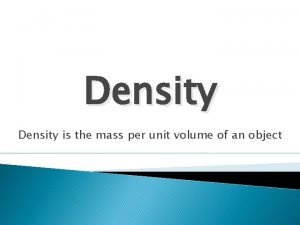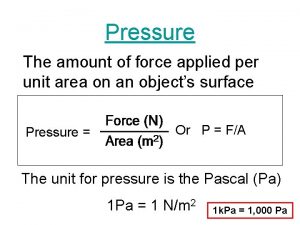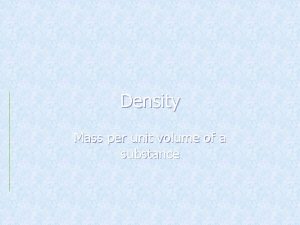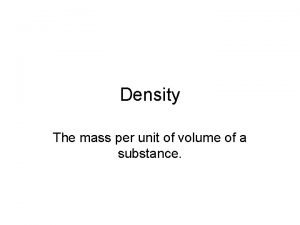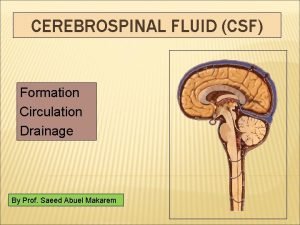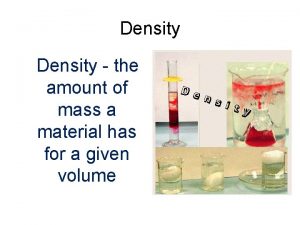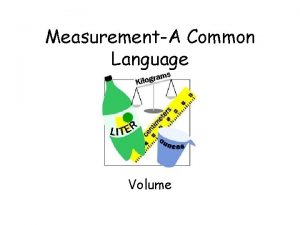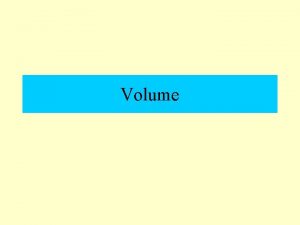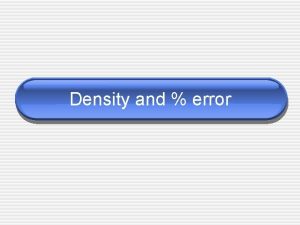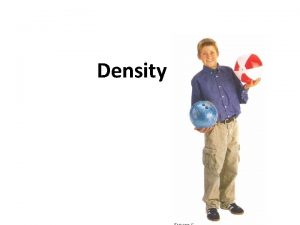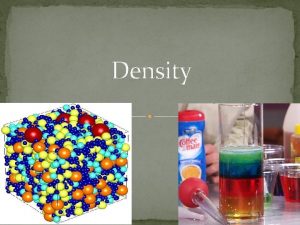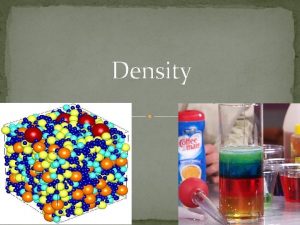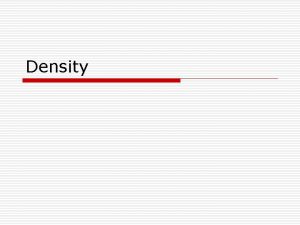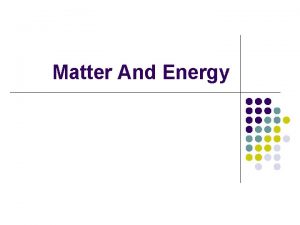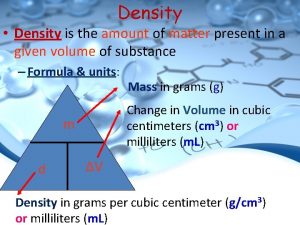DENSITY Density amount of matter per unit volume

















- Slides: 17

DENSITY §Density = amount of matter per unit volume D = m/v (g/cm 3) Mass usually expressed in grams Volume usually expressed in cm 3 or ml etc.

The “DMV” Triangle for Volume, Mass, and Density = M V Volume = M D Mass = D x V M ÷ ÷ D X V

What would take up more space? ? ? kilogram of feathers…. . or a kilogram of steel? ? OR A

Density is the measure of the “compactness” of a material n. How close the atoms or molecules are to each other n. More than “heaviness” - density includes how much space an object takes up!! n. All substances have density including liquids, solids, and gases

“Compactness”

Gases n. How much kinetic energy do the molecules have? ? n. The greater the kinetic energy n ……the greater the volume n …… and the less dense that gas is!! n. Therefore, cold air is more dense than warm air n

Low pressure weather system means warmer air tends to rise, High pressure systems indicate a colder more dense air mass that will……. SINK!!!

LIQUIDS n The more dissolved solids in a solution, the more dense (such as ocean water) n Cold water in lakes tend to sink (this creates a constant mixing of water, nutrients, and other substances) Kinetic energy again!! Denser layers to less dense layers…. .

What would happen? ? n Mercury density = 13600 kg/m 3 n Lead density = 11340 kg/m 3

Lead floats on liquid mercury!

Solids Ice vs. water…. .

SOLIDS n Ice is less dense than water (which is why lakes and ponds have a thin layer of ice covering in winter, with water underneath) n Various rocks, woods, metals have a characteristic density specific to that substance Wouldn’t you like to have a bunch of THIS dense material?

Archimedes and the Kings Crown

Factors affecting Density n Temperature n Pressure

Factors affecting Density n Dissolved solids – in liquids n Concentration and kind of substances

DETERMINING DENSITY n Regular Shapes – mass, then determine the volume by formula EX: cubes, cylinders, spheres, cones, etc. n Irregular shapes – mass, then measure displacement of a liquid (usually water) by that irregularly shaped object 1. Use a graduated cylinder 2. Add water to a predetermined level - record. 3. Gently drop in the irregularly shaped object. 4. Read the graduated cylinder – record. 5. Subtract the first water level from the second – this is the volume

Density Table SINK or FLOAT In Water (D = 1. 0 g/m. L) Float Sink (alcohol) Float (fuel) Float
 Mass per unit volume
Mass per unit volume Pressure is the force per unit
Pressure is the force per unit What is distance covered per unit of time
What is distance covered per unit of time Mass of a substance per unit volume
Mass of a substance per unit volume What is the mass per unit of volume
What is the mass per unit of volume Amount of csf produced per day
Amount of csf produced per day Contraindications of lumbar puncture
Contraindications of lumbar puncture Amount of csf produced per day
Amount of csf produced per day Dmv triangle chemistry
Dmv triangle chemistry Section 1 composition of matter
Section 1 composition of matter Grey matter reliaquest
Grey matter reliaquest Section 1 composition of matter
Section 1 composition of matter Chapter 2 section 1 classifying matter answer key
Chapter 2 section 1 classifying matter answer key Gray matter and white matter
Gray matter and white matter Classification of matter section 1 composition of matter
Classification of matter section 1 composition of matter Gray matter and white matter
Gray matter and white matter Pallium telencephalon
Pallium telencephalon Energy naturally flows from warmer matter to cooler matter.
Energy naturally flows from warmer matter to cooler matter.
